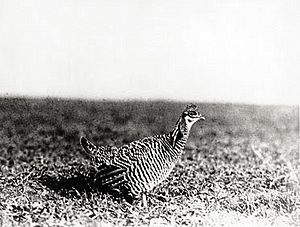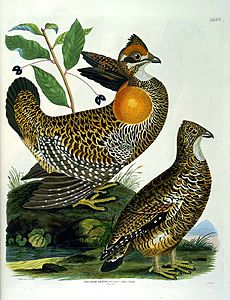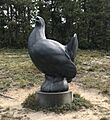Heath hen facts for kids
Quick facts for kids Heath hen |
|
|---|---|
 |
|
| Live male specimen photographed ca 1909 | |
| Conservation status | |
| Scientific classification |
|
| Kingdom: | Animalia |
| Phylum: | Chordata |
| Class: | Aves |
| Order: | Galliformes |
| Family: | Phasianidae |
| Genus: | Tympanuchus |
| Species: | |
| Subspecies: |
†T. c. cupido
|
| Trinomial name | |
| Tympanuchus cupido cupido (Linnaeus, 1758)
|
|
The heath hen (Tympanuchus cupido cupido) was a special type of greater prairie chicken. It was a large bird from North America that belonged to the grouse family. Sadly, it became extinct in 1932. Some people even thought it was its own species.
Heath hens used to live in bushy, open areas along the coast of North America. This stretched from New Hampshire down to Virginia. Long ago, they might have even lived as far south as Florida. Other prairie chickens lived in open prairies from Texas up to Canada.
During colonial times, heath hens were very common in their habitat. Settlers hunted them a lot for food. Some people even think the Pilgrims ate heath hens at their first Thanksgiving dinner, not wild turkey. By the late 1700s, heath hens were so cheap and plentiful that they were known as "poor man's food."
Contents
About the Heath Hen
The heath hen looked a lot like the greater prairie chicken found in the Great Plains. However, it was a bit smaller. These birds were about 17 inches (43 cm) long and weighed around two pounds (0.9 kg).
Heath hens had some unique features. Their feathers often had a strong reddish color, especially on their chest. They also had thicker stripes on their chest and sides. Their ear-like feathers, called pinnae, were usually pointed. Their tails were a grayish-brown color.
Why the Heath Hen Disappeared
The heath hen population quickly dropped because of too much hunting. By the 1840s, or at least by 1870, all heath hens on the mainland were gone. Only about 300 were left on Martha's Vineyard, an island off Massachusetts.
By 1890, this number fell to just 120–200 birds. This was mainly due to feral cats hunting them and people poaching (hunting illegally). By the late 1800s, only about 70 heath hens remained.
Efforts to Save Them
To protect the remaining birds, hunting them was banned. In 1908, the "Heath Hen Reserve" was created. This area is now called the Manuel F. Correllus State Forest. The population quickly grew to almost 2,000 birds. By the mid-1910s, watching the birds on their special lekking grounds (where males display to attract females) became a popular tourist activity.
The Final Decline
Despite these efforts, several problems led to the heath hen's final decline:
- A big fire in 1916 during nesting season destroyed many nests.
- Harsh winters made it hard for the birds to survive.
- Many predatory northern goshawks arrived, hunting the heath hens.
- Inbreeding (when closely related animals reproduce) made the birds weaker.
- There were too many male birds compared to females.
- An illness called blackhead disease, possibly spread by poultry, also affected them.
After a brief recovery to 600 birds in 1920, the population began its final drop. By 1927, only 11 males and two females were left. By the end of that year, only a handful remained, all of them males.
Booming Ben
After December 8, 1928, it seems only one male heath hen survived. People lovingly called him "Booming Ben." He was last seen on his traditional lekking ground on March 11, 1932. He was about 8 years old and likely died shortly after.
Conservation Lessons
The heath hen was one of the first bird species that Americans tried to save from extinction. As early as 1791, a bill was introduced in the New York State legislature to protect "heath-hen and other game." Even though the law passed, it was hard to enforce.
While the effort to save the heath hen didn't succeed, it helped pave the way for protecting other species. However, some choices made for the reserve might have actually sped up the heath hen's extinction. Fires were a natural part of the heath hen's environment. But when people tried to stop all fires, too much undergrowth built up. This meant that a normal fire, like the one in 1916, became a disaster. Not understanding the area's natural fire ecology (how fires affect the environment) also led to problems.
Today, scientists are thinking about bringing back the original open, bushy habitat in the State Forest. They are also discussing introducing the closely related greater prairie chicken. This bird could act as an "umbrella species," meaning its health would show if the habitat is good for other species too. More research is needed to understand the best way to protect these types of birds.
Images for kids
-
Stuffed female specimen at Boston Museum of Science
See also
 In Spanish: Gallo de las praderas grande para niños
In Spanish: Gallo de las praderas grande para niños







